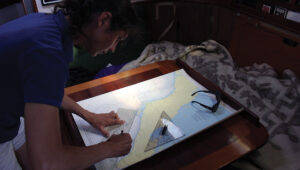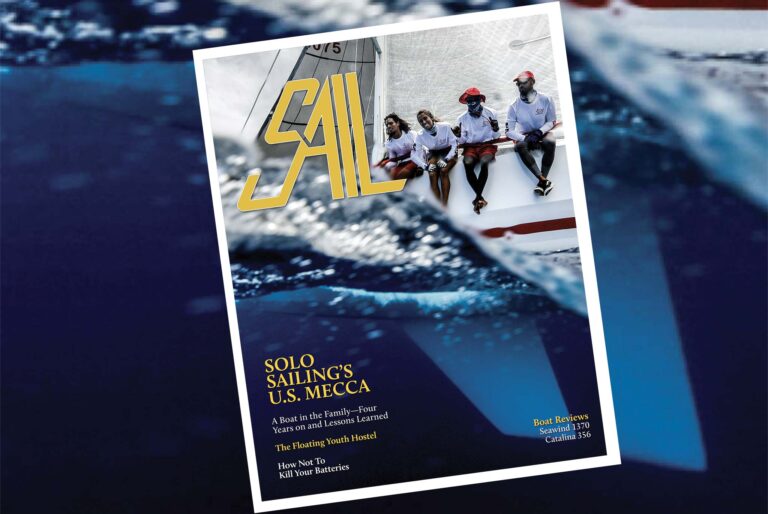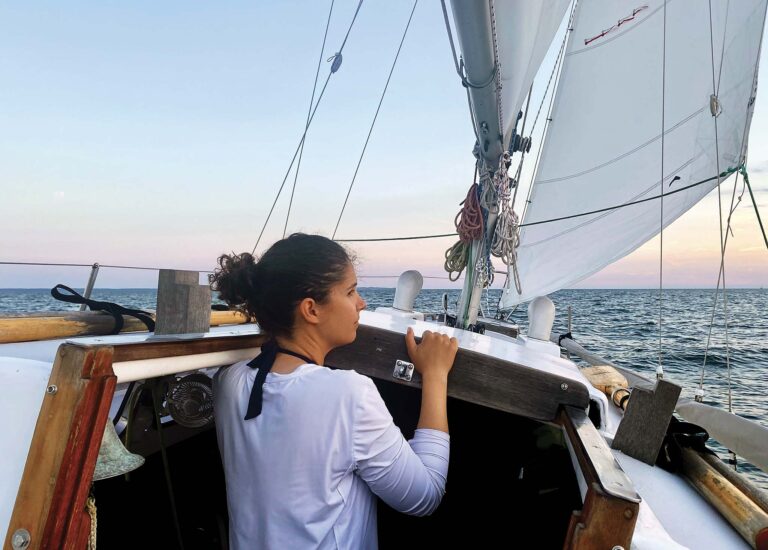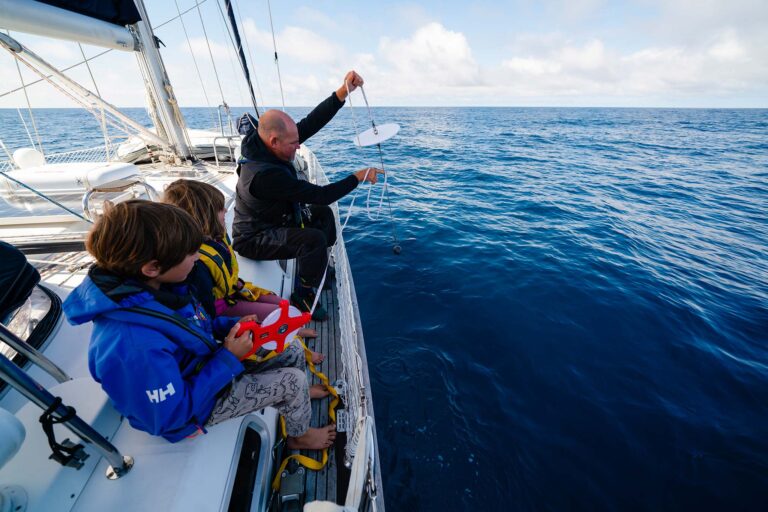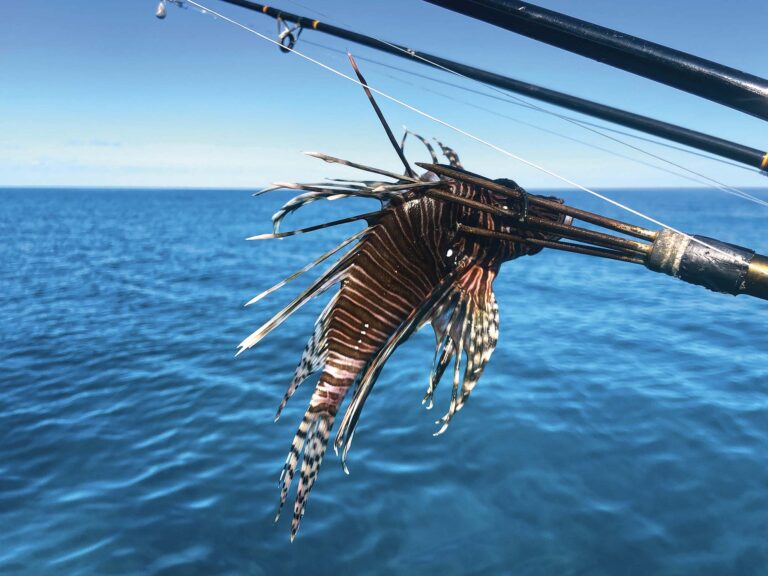If you go over the side offshore, you’re dead. If we get you back, you’re lucky. The edge of the boat is a 2,000-foot cliff—you go over, the consequences are the same, it just takes a little longer.
—Andy Schell, 59 North Sailing, SAIL, April 2019

Coast Guard statistics are sobering. In the six-year period from 2016 through 2021, a total of 1,771 souls fell overboard in U.S. waters, and 64% of them perished.
Any discussion of sailor overboard procedure, equipment, and technology must start with an emphasis on prevention. Good nonskid, plentiful handholds, proper use of tethers, physical fitness, and most importantly, situational awareness, are all essential in keeping crew on the inside of the rail.
Unfortunately, sailors still do fall over the side, and it’s important to consider the current state of the technology available for rescuing them. The bad news is that despite advances, the odds are still heavily against rescue if you fall off the boat. The good news is that technologies continue to evolve with the intention of improving those odds.
Modern 406MHz satellite PLB technology includes GPS location embedded in the distress signal, providing precise victim location for rescuers. Newer equipment is also capable of receiving a return link service signal assuring the victim that the emergency message has been received.
The latest addition from ACR Electronics, the ResQLink AIS PLB, for the first time combines 406 PLB and AIS technologies into one unit small enough to fit in an inflatable life vest and activate when the life vest deploys. It—and an equivalent product made by Ocean Signal for the European market—have both recently won prestigious marine industry awards for their advancements.
So, what should you be wearing on or in your life vest? With the reminder that the absolute first line of defense is to not go off the boat in the first place, let’s take a look at these technologies, how they work, and the systems in place to support them.

Eyes in the Sky: 406 PLBs and EPIRBs
The Personal Locator Beacon (PLB) is a compact version of the mothership’s Emergency Position Indicating Radio Beacon (EPIRB). This device can be secured to a life jacket and, when activated, will send a distress signal via satellite to COSPAS-SARSAT.
Only 72 days after the first satellite in this system was launched in 1982—initially intended to find downed planes—the crew of the capsized trimaran Gonzo became the first sailors to be rescued thanks to it. (Notably, they were rescued from the boat’s hull—not from in the water.)
Since then, the technology has continued to improve. Sixty-four more satellites at different orbiting altitudes have been added, providing a speedier relay of the distress call from the victim to the Rescue Coordination Center. New satellites continue to be added to the potent MEOSAR orbit, which should continue to speed up transmission times; signals that used to take hours to transmit are now usually sent in a few minutes.
How rescue agencies interpret and act on these signals is a more subtle point. Here’s an eye-popping statistic: 96% of distress calls received by COSPAS-SARSAT are false alarms. More than 3.2 million EPIRBs and PLBs are now in circulation—that’s a lot of handsome little boxes that might capture the imagination of a child, get smashed off the side of a pilothouse and into the sea by a powerful wave, or get jostled to life inside a hiker’s pack.
An expired battery will send a distress call automatically with its dying breath, and preposterous as it may sound, Christmas morning produces far more false alarms than any other day of the year. People love to pull the device out of the box and play with its buttons.
Once a distress signal is received, the rescue center staff has 30 minutes to try and tease out the difference between a true emergency and a false alarm. They call the contact phone numbers associated with the beacon registration, and they check if the location matches up with the registered float plan. When a distress signal can’t be confirmed because a device isn’t registered, is registered to the previous owner of the boat, or is registered with incomplete information, a rescue mission can be delayed.
So first and foremost, make sure that your EPIRB or PLB battery is not near expiration and that the unit is fully registered with up-to-date information including a description of the vessel, multiple emergency contacts, and a float plan. In the U.S., you can provide or update your information here: beaconregistration.noaa.gov
Interestingly, multiple distress signals from the same precise geography at the same time give the rescue center staff greater confidence in the reality of the distress. If all crew members in a life raft activate PLBs secured to their life vests in addition to the EPIRB in their ditch bag, they are sounding a louder alarm than they could by setting off the EPIRB alone.
After the distress signal spends a few minutes bouncing off satellites and the rescue center has spent up to 30 minutes confirming the authenticity of the distress, they will assign a search and rescue (SAR) mission to the best available asset. In U.S. waters, this is usually the Coast Guard. Once an alarm sounds in a Coast Guard base, crews have up to 30 minutes to gear-up, get a briefing, do pre-flight checks, and get their “ready-bird” off the ground or their “ready-boat” off the dock.
Captain Steve Kenney, retired USCG, says the EPIRB/PLB distress signal is a vast improvement over a phoned-in report of an overdue vessel or a garbled mayday call.
“All of a sudden, we know who, we know what, and we know where,” he says. “People panic. Technology doesn’t.”
That said, while this technology may clarify the rescue mission, it still may not speed it up enough for someone in cold water. Coast Guard helicopters cruise at 140 knots and have a range of up to 300 miles offshore. Outside that range, victims in midocean waters will have to rely on rescue by a ship participating in the Automated Mutual Assistance Vessel Rescue Program known as AMVER. On any given day, more than 7,000 participating ships are on plot in the world’s oceans and are willing to assist in a rescue. Depending on their position, their travel time to the person in the water can be hours or even days.
All these compounding delays are more tolerable for a crew in a life raft (or a hiker with a sprained ankle) than for a sailor with no shelter, floating in cold, open water. Survival times are closely associated with water temperature. The technology does work though. On average, seven lucky people are rescued by it every day.
Eyes in the Boat: Personal Automatic Identification System (AIS) and Separation Alarms
In most cases, the mothership offers the best hope for a quick rescue of her lost crew. The personal AIS, another device secured to the life jacket, is designed to help her find them.
This technology, introduced in 2009, relays the GPS coordinates of the person overboard to the AIS-equipped chart plotter screen on the mothership. Once activated, the sailor overboard and lost in a seastate can be seen once again on the screen. Person overboard icons will also pop up on the screens of other nearby vessels equipped with modern AIS-linked chart plotters, letting them help as well.
Anyone who has ever worked with AIS knows that the system can feel kind of wishy-washy. Vessel data is sometimes acquired slowly, first with just an MMSI number, then a bit later with a boat name and a set of stats. A lot of this is by design; to ensure the AIS network doesn’t get bogged down with excessive traffic, the system prioritizes some traffic over others, such as fast-moving vessels over anchored vessels. The personal AIS device implements a clever workaround. The unique Pre-Approved TDMA signal that it produces lets it cut to the head of the line and transmit at a fast rate of eight signals per minute, with the highest priority in the slot map.
Unfortunately, the system has limitations.
The AIS signal travels via line of sight between the device’s antenna and the VHF antenna on the nearby boats. The person overboard wearing the personal AIS has the lowest possible antenna height, and in real-world situations, that signal can be obscured by waves and spray. Even in calm conditions, range is limited.
To conserve battery life, the device transmits at low power (1 watt; conversely, class A transceivers transmit at up to 12.5 watts). Manufacturers claim the signal can be received up to 5 miles from the person in the water. Beyond this range, the sailor overboard has once again been lost from sight.
If all goes well and the signal is received by the mothership, much still depends on that boat and its crew’s ability to successfully find and retrieve the person overboard—a task that is extremely difficult or sometimes impossible to do, even if crewmembers are trained in sailor overboard procedures.
Despite its limitations, the AIS signal offers the best hope for a quick rescue. With a person in the water, time trumps all.
Even better is if the person overboard is never out of sight, and this is where a separation alarm offers another layer of safety. Every crewmember secures an electronic tag to their life jacket. Operating via Bluetooth from a base such as a tablet or a phone, this system will sound a loud alarm if someone goes beyond about 100 feet from that base. This ensures that no one goes overboard unnoticed. For sailors traveling alone with an engine on, this system can also be rigged to shut off the engine when it alarms.

The Combo Platter
Given all these technologies aimed at finding and rescuing someone who goes overboard, the prudent mariner would secure a separation alarm tag, a 406 PLB, a personal AIS, and a strobe light to their life jacket. That sailor would be wearing one helluva bulky life vest. Potentially, it could be such a hassle that some may be dissuaded from donning it all together. As common wisdom goes, the safest life vest is one you’re actually going to wear.
That’s where the latest technology has made an advance. ACR’s ResQLink AIS PLB includes a state-of-the-art, MEOSAR-compatible 406Mhz PLB signal with GPS positioning and return link service (the latter switches a light on the device from green to blue, letting the wearer confirm that the signal has been sent and received). Significantly, the unit also includes a personal AIS.
Additional features are a strobe and an infrared light to help keep the overboard person illuminated even at night or in fog. It also emits a 121.5-mhz homing signal—sometimes used by rescue professionals in the final mile of the search—and includes an app that lets you test the device yourself using your phone.
The device is secured to the air bladder inside the life vest. When the vest inflates, the device activates (it can also be manually turned on).
One notable item not included is a separation alarm. It could have been added by using ACR’s own separation alarm technology, but the builder decided to omit this feature to save battery weight and bulk. A DSC alert signal was omitted for the same reason. The thing has to fit into a life vest after all.
Most chart plotters can be set to alarm when the AIS person overboard signal is detected, and this could be considered an adequate separation alarm. However, the initial AIS signal chirps 20-30 seconds after the vest inflates, far longer than the 5-8 seconds it would take for a separation alarm system to notice a lost crewmember. The AIS alarm works when communications are established; the separation alarm works when communications are disrupted—a more reliable strategy. Perhaps future versions of this device will remedy this omission.
Once in hand, you must register the new ACR ResQLink AIS PLB with NOAA as a 406 PLB. Next, you should test it with the downloadable app, and also test to make sure the AIS icon appears and alarms on the mothership’s chart plotter. Lastly, secure it properly to the life vest to ensure the auto-activation feature will work. It doesn’t float, so make sure the safety lanyard is lashed down well. The device is compatible with nearly all inflatable life vests.
Ocean Signal’s rescueME PLB3-AIS is an equivalent product for the European market (Ocean Signal is a subsidiary of ACR).
Electronic life vest devices are not a panacea. Finding and recovering crew overboard can still be incredibly difficult; taking steps to stay on the boat in the first place is of course the best option. But at a minimum, these devices should provide the overboard sailor and the crew remaining onboard a bit of hope.
Know Your Acronyms
AMVER: Atlantic Merchant Vessel Emergency Reporting (Now known as the Automated Mutual Assistance Vessel Rescue Program. This important program has a long history of name changes, but the initial acronym has become so universally recognized it has never been changed.)
AIS: Automatic Identification System
COSPAS – SARSAT: Cosmicheskaya Sistema Poiska Avariynyh Sudov (Космическая Система Поиска Аварийных Судов) – Search and Rescue Satellite-Aided Tracking
DSC: Digital Selective Calling
EPIRB: Emergency Position Indicating Radio Beacon
MEOSAR: Medium-Altitude Earth Orbiting Search and Rescue
MMSI: Maritime Mobile Service Identity
OLAS: Overboard Location Alert System
PATDMA: Pre-Approved Time Division Multiple Access
PIW: Person In Water
PLB: Personal Locator Beacon
RCC: Rescue Coordination Center
RLS: Return Link Service
SAR: Search And Rescue
SOLAS: Safety Of Life At Sea
Christopher Birch and his wife, Alex, are cruising aboard their 36-foot Morris Justine. Follow their voyage at eaglesevensailing.com.
June/July 2023


